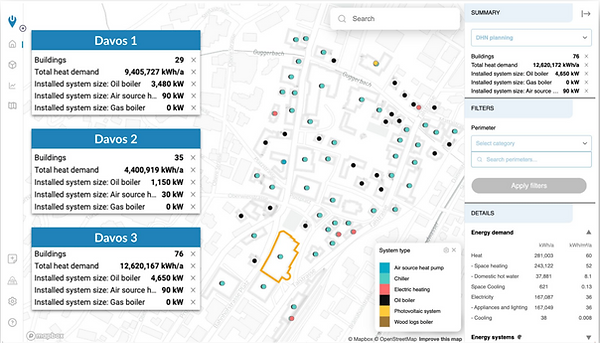
District Heating Planning
CKW plans the most rewarding district heating networks
CKW needed to know which areas to prioritize for a new district heating network (DHN) deployment.
Today, this activity involves a lot of manual effort: collecting building attributes from spreadsheets, applying complex formulas for estimating demands and mapping this data to footprints in a GIS tool for visualization and prospection purposes.
With Urbio, the full process was automated, hours of work were saved, and the team could focus on the exploration of scenarios with the support of maps and key metrics.

Customer
CKW
Sector
Utility
Location
Switzerland
Challenge
CKW approached Urbio to overcome 3 issues:
-
Lack of data on buildings and areas of interest.
-
Changing environment requiring multiple repetitions of analyses
-
Time-consuming methodology for evaluating multiple scenarios
Benefits
5x faster analysis enabled by instant map generation and computation of metrics
-
ROI achieved faster by sorting out and focusing on high-impact buildings
-
3x more scenarios evaluated within area of interest for feasibility studies
-
High data accuracy guaranteed by relying on certified industry norms and enhanced by Machine Learning and energy models
-
Streamlined workflow from data import to visualization of building data, to calculation of key project metrics
Solution
CKW needed to know which areas to prioritize for a new district heating network
(DHN) deployment. Today, this activity involves a lot of manual effort: collecting building attributes from spreadsheets, applying complex formulas for estimating demands and mapping this data to footprints in a GIS tool for visualization and prospection purposes. With Urbio, the full process was automated, hours of work were saved, and the team could focus on the exploration of scenarios with the support of maps and key metrics.
Centralize available data
-
Relying on Urbio's flexible import features, CKW quickly uploaded all files collected from different sources (municipality, utility and surveys) into the platform.
-
Next, they structured this data into a unique digital Twin making up for gaps in data thanks to Urbio's curated list of open data and advanced models.

Identify most suited areas
-
From the Digital Twin, the engineers generated multiple maps of the area highlighting the energy systems, the building uses and heat density.
-
Then, they applied filters to pinpoint locations of key buildings (e.g. public buildings, waste-heat producers, major heat consumers) to delineate suitable areas.

Centralize available data
-
Relying on Urbio’s flexible import features, CKW quickly uploaded all files collected from different sources (municipality, utility and surveys) into the platform.
-
Next, they structured this data into a unique Digital Twin making up for gaps in data thanks to Urbio’s curated list of open data and advanced models.


I used Urbio for several district heating network projects in order to accelerate the development of our renewable activities. I am very happy with the results, in particular the screenshots and metrics which I showcased to our partners.
Rafael Mesey, Head of Department New Energy
How Urbio helps CKW

Data Factory
All data in one single place of truth

Multiple languages
App available in German, French or English

Generative Design
Automated scenario design
Outstanding support
Custom training and live chat in-app


Digital Twin
Interactive, filterable maps to showcase

Custom Reports
Personalized reports and sales proposals
